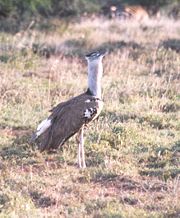Bustard
| Bustards | ||||||||||
|---|---|---|---|---|---|---|---|---|---|---|
 Kori Bustard
|
||||||||||
| Scientific classification | ||||||||||
|
||||||||||
| Genera | ||||||||||
|
See text. |
Bustards are large terrestrial birds mainly associated with dry open country and steppes in the Old World. They make up the family Otididae (formerly known as Otidae). They were renowned by the ancient Arabs for being unnaturally stupid.[1]
Bustards are omnivorous and nest on the ground. They walk steadily on strong legs and big toes, pecking for food as they go. They have long broad wings with "fingered" wingtips, and striking patterns in flight. Many have interesting mating displays, such as inflating throat sacs or elevating elaborate feathered crests. The female lays three to five dark, speckled, eggs in a scrape in the ground, and incubates them alone[2].
Bustards are gregarious outside the breeding season, but are very wary and difficult to approach in the open habitats they prefer.[3]
Contents |
Status
Most species are declining or endangered through habitat loss and hunting, even where they are nominally protected.[3] Two great bustard eggs were recently laid in Britain for the first time in over 150 years[4], but were unfertilized—probably owing to the still juvenile male population. The last bustard died out in Britain in about 1832, but the bird is being reintroduced through batches of chicks imported from Russia.[3]
Floricans
Some Indian bustards are also called Floricans. The origin of the name is unclear. Jerdon writes in his bird of India (1862)
I have not been able to trace the origin of the Anglo-Indian word Florikin, but was once informed that the Little Bustard in Europe was sometimes called Flanderkin. Latham gives the word Flercher as an English name, and this, apparently, has the same origin as Florikin.
—Jerdon's Birds, 2nd ed. ii. 625.
The Hobson-Jobson dictionary however casts doubt on this theory stating that
We doubt if Jerdon has here understood Latham correctly. What Latham writes is, in describing the Passarage Bustard, which, he says, is the size of the Little Bustard: Inhabits India. Called Passarage Plover. … I find that it is known in India by the name of Oorail; by some of the English called Flercher. (Suppt. to Gen. Synopsis of Birds, 1787, 229. Here we understand the English to be the English in India, and Flercher to be a clerical error for some form of floriken.
Species in taxonomic order
FAMILY: OTITIDAE
- Genus: Otis
- Great Bustard, Otis tarda
- Genus: Ardeotis
- Arabian Bustard, Ardeotis arabs
- Kori Bustard, Ardeotis kori, subspecies kori and struthinuclus
- Great Indian Bustard, Ardeotis nigriceps
- Australian Bustard, Ardeotis australis
- Genus: Chlamydotis
- Houbara Bustard, Chlamydotis undulata, subspecies undulata and fuertaventurae
- Macqueen's Bustard, Chlamydotis macqueenii[5]
- Genus: Neotis
- Ludwig's Bustard, Neotis ludwigii
- Stanley Bustard, or Denham's Bustard, Neotis denhami
- Heuglin's Bustard, Neotis heuglinii
- Nubian Bustard, Neotis nuba
- Genus: Eupodotis
- White-bellied Bustard, Eupodotis senegalensis
- Blue Bustard, Eupodotis caerulescens
- Karoo Bustard, Eupodotis vigorsii
- Rüppell's Bustard, Eupodotis rueppellii
- Little Brown Bustard, Eupodotis humilis
- Genus: Lophotis
- Savile's Bustard, Lophotis savilei
- Buff-crested Bustard, Lophotis gindiana
- Red-crested Bustard, Lophotis ruficrista
- Genus: Afrotis
- Black Bustard, Afrotis afra
- White-quilled Bustard, Afrotis afraoides
- Genus: Lissotis
- Black-bellied Bustard, Lissotis melanogaster
- Hartlaub's Bustard, Lissotis hartlaubii
- Genus: Houbaropsis
- Bengal Florican, Houbaropsis bengalensis
- Genus: Sypheotides
- Lesser Florican, Sypheotides indica
- Genus: Tetrax
- Little Bustard, Tetrax tetrax
Notes
- ↑ Hayawān, Encyclopedia of Islam
- ↑ Archibald, George W. (1991). Forshaw, Joseph. ed.. Encyclopaedia of Animals: Birds. London: Merehurst Press. pp. 98-99. ISBN 1-85391-186-0.
- ↑ 3.0 3.1 3.2 Bota, G., J. Camprodon, S. Mañosa & M.B. Morales (Editores). (2005). Ecology and Conservation of steppe-land birds. Lynx Editions. Barcelona ISBN 84-87334-99-7; 978-84-87334-99-3.
- ↑ [1]http://www.wildlifeextra.com/go/news/bustard-eggs.html
- ↑ Macqueen's Bustard has recently been split from the Houbara Bustard as a full species.
References
- Sibley, Charles G.; Jon E. Ahlquist (1990). Phylogeny and Classification of the Birds : A Study in Molecular Evolution. New Haven: Yale University Press. ISBN 0-300-04085-7.
- Knox, Alan G.; Martin Collinson, Andreas J. Helbig, David T. Parkin & George Sangster (October 2002). "Taxonomic recommendations for British birds". Ibis 144 (4): 707–710. doi:. http://www.blackwell-synergy.com/doi/full/10.1046/j.1474-919X.2002.00110.x.
- Ecology and conservation of Steppe-Land birds by Gerard Bota et al. International Symposium on Ecology and Conservation of Steppe-land birds. Lynx Edicions 2005. 343 pages. ISBN 84-87334-99-7
External links
- Bustard videos on the Internet Bird Collection